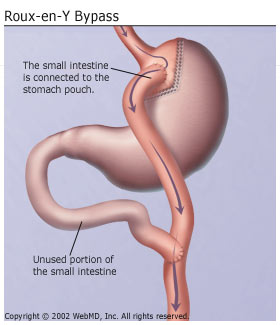Obesity:
- Complications of obesity
- Medical treatment
- Surgery for obesity
- Outcomes of surgery
- Complications of surgery
- NICE guidelines
- Life after surgery
Laparoscopic surgery for obesity:
Combination - The combination operations serve to reduce the capacity of the body to digest the constituents of the meal eaten by the person to maintain their current body weight.
These procedures rely on combining a more modest reduction in the stomach capacity with a modest reduction in the available bowel to absorb the ingested meal. They are not associated with such significant side-effects as the "pure" bypass procedures.

Roux- En Y Bypass (RNY) - This type of gastric bypass is becoming popular with obesity surgeons in the United States and Europe.
The stomach is divided to produce a small pouch which aids in generating early fullness. The modest bypass portion of the procedure eliminates food from the duodenum which appears to reduce the sensation of hunger by manipulating levels of GLP1 and PYY in the person.
The theory behind the success of this procedure seems to be the changes in the levels of hormones produced by the elimination of the duodenum from the pathway taken by food.
Diabetes is often eliminated within days of surgery and over 80% of patients with Type 2 diabetes find their disease diasppears within weeks of surgery. Often before significant amounts of weight are lost.
There are complications from this surgery, which are generally related to the technical points of producing this type of bypass procedure:
They include narrowing of the join to the stomach, intestinal obstruction due to spaces being formed within the intestinal loops and leakage of the joins formed.